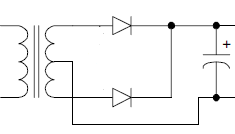Hey all -
I feel like this thread might be applicable to more than just LM386 circuits, so bear with me...
I am building a (purposely lo-fi) amp based on the LM386. It is powered by a 10 V DC power supply that I put together. I am using the bare-bones layout from TI - using minimal gain of 20.
Schematic:
Here's my problem:
When there is no input to the amp, it is dead silent. When I plug in my iphone to my headphone --> line level converter, it is STILL silent. When I hit play, I get white noise and distorted music, no matter the volume level. When I hit stop, I still have the white noise and it is proportional to the volume level on the iphone.
This does not happen when the circuit is powered with a 9 v battery. It is nice and clean and (mostly) noise free. Some of the noise is due to the unshielded jumpers I am using to connect things, but the noise is not there when the iphone is not plugged in (but the jumpers are left attached to the circuit).
What to do here?
Thanks in advance!!!
I feel like this thread might be applicable to more than just LM386 circuits, so bear with me...
I am building a (purposely lo-fi) amp based on the LM386. It is powered by a 10 V DC power supply that I put together. I am using the bare-bones layout from TI - using minimal gain of 20.
Schematic:
An externally hosted image should be here but it was not working when we last tested it.
Here's my problem:
When there is no input to the amp, it is dead silent. When I plug in my iphone to my headphone --> line level converter, it is STILL silent. When I hit play, I get white noise and distorted music, no matter the volume level. When I hit stop, I still have the white noise and it is proportional to the volume level on the iphone.
This does not happen when the circuit is powered with a 9 v battery. It is nice and clean and (mostly) noise free. Some of the noise is due to the unshielded jumpers I am using to connect things, but the noise is not there when the iphone is not plugged in (but the jumpers are left attached to the circuit).
What to do here?
Thanks in advance!!!
Oh sorry - the center tap of the secondary is grounded. Not shown in the photo. The negative side of the rectifier is floating. Is that a problem?
A single supply does not need a center tap.
And the negative side of the rectifier bridge is your negative rail. (= ground)
And the negative side of the rectifier bridge is your negative rail. (= ground)
Why do you need a transformer on the input ?
It sounds to me like you are applying to much signal to the LM386. Why not replace the transformer with a 10K pot (or preset) as shown in the application notes. I would then AC couple the pot input to the ipod/phone with a 10uf cap. Finally add a low value resistor (say 33ohm) directly across the ipod output (so you need two for stereo) to simulate the headphone loading. This is needed because some Class D output stages rely on the phones as part of the output filter. If you don't ultimately want the 10K volume control then you can replace it with a suitable fixed divider having first got the amp working OK.
It sounds to me like you are applying to much signal to the LM386. Why not replace the transformer with a 10K pot (or preset) as shown in the application notes. I would then AC couple the pot input to the ipod/phone with a 10uf cap. Finally add a low value resistor (say 33ohm) directly across the ipod output (so you need two for stereo) to simulate the headphone loading. This is needed because some Class D output stages rely on the phones as part of the output filter. If you don't ultimately want the 10K volume control then you can replace it with a suitable fixed divider having first got the amp working OK.
- Status
- Not open for further replies.
